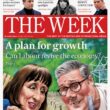UK magazine publisher Mark Wood knew what everyone was thinking: “The iPad is not the saviour of magazines”. But the calm-down words came just as it looked as if Steve Jobs’ last great creation was, indeed, coming to the rescue of the gasping magazine industry. It all happened in October. Eighteen months after the launch of iPad, Apple introduced its Newsstand app. Meanwhile, 5,000 miles away from California, the UK hobby-tech magazine publisher Future Plc was rocked by another of its periodic crises: profits down, share price slides, CEO quits.
Former TV news chief Wood took the helm as the UK-based publisher flooded the new iTunes Newsstand with 65 titles. Within a few months, it had clocked up 10 million downloads, becoming arguably the leading worldwide publisher on iPad. The sugar-rush of digital sales had come to the rescue of the magazine industry – and Future.
The fragile but funky Future was founded 27 years ago by TED guru Chris Anderson. (http://flashesandflames.com/2011/10/04/) Typically, it bounced back from the 2011 profit warnings to report iPad sales of 12 million apps, 500,000 ‘magazines’, and digital growth at last starting to compensate for hard copy losses. The company’s tech-as-porn monthly T3 rapidly became a Newsstand bestseller.
The South West, Bath-based publisher had moved quickly into iPad editions but most other magazine companies were not far behind. US and UK magazines are positively purring about a device that meets the needs of “magazine journalism that is all about packaging information beautifully and usefully. Digital magazines look simply gorgeous on a glass iPad screen”. Hearst is celebrating its race to 600,000 iPad edition sales. The Economist predicts that 70% of its subscriptions will be digital within two years. The reviving Reader’s Digest sees 400,000 digital sales exceeding print in 2012. And ‘news’ too is getting on famously with the iPad. The Financial Times may have more digital subscribers than print by 2013, and The Times is claiming 120,000 iPad subscriptions, most from new customers. Even News Corp’s digital-only The Daily has finally come alive with the iPad app. Felix Dennis’s quietly booming The Week (http://flashesandflames.com/2011/07/22/ ) has achieved more than 100,000 downloads, apparently with “zero impact” on its inexorable hard copy subs growth.
What’s more, the iTunes Newsstand has given publishers a dramatic boost in international revenues especially for specialist magazines. T3’s 270,000 downloads in February, produced sales of 25,500 monthly iPad editions – 48% from outside the UK. The sheer thrill is on the faces of Bauer’s UK executives whose Empire movie magazine app is launching in the US, to build on the reported 500,000 American monthly visits to the magazine’s site. It’s an exciting but low-risk move for the magazine whose high-flying former owner EMAP was literally broken apart 14 years ago by an egregious boots-on-the-ground foray into the US (http://flashesandflames.com/2011/09/17/).
The Newsstand is clearly set to have a similar impact on magazines (and newspapers) as the launch of iTunes itself had on music. It’s already changed the face of the iPad app economy and transformed the rank and visibility of magazine brands, which now comprise 9 of the 10 highest grossing iPad apps in the US. Of these, 8 are digital editions of magazines. No fewer than 34 of the top 50 iPad apps now are magazine editions. The second biggest grossing lifestyle app is Hearst’s Cosmopolitan, the world’s largest selling magazine. As if to reinforce the perfect ‘fit’, a recent US study showed that owners of tablets and e-readers spend 50% more time reading magazines than the general population.
It is easy to believe that magazines were always better suited to the well-packaged calm of iTunes apps than the chaos of the internet. And a return to lie-flat reading and the arrival of magazine-size, high-resolution screens has been good for business. But let’s not get carried away. The iPad Newsstand fever follows a tormenting period during which magazine publishers feared all but oblivion due to falling copy sales, cover prices and advertising yields – and agile new competitors.
Celebrity coverage which turbocharged sales of weekly magazines and profits across the whole market has now been eclipsed by Twitter. If you’re interested in this celeb, why not follow her/him yourself – fast and for free? Advertising-dependent lifestyle monthlies found themselves starved by the growth of advertising alternatives – and recession. Specialist magazines, many of them robbed of classified ads by digital newbies, faced ruin in a world of falling cover prices.
Suddenly, the clouds have lifted. But these are still early digital days for magazines. There is no dearth of economic challenges ahead as publishers seek to turn readers’ renewed enthusiasm into longterm profitability. Try these for a start:
Content. Most current iPad editions are (more or less) facsimiles of the printed magazines. Hearst’s international magazines chief Duncan Edwards told a recent London conference that what is now the world’s largest women’s magazine publisher has no plans to include interactive content in digital editions, and that readers will pay more for digital editions: “People thought we’d re-imagine the magazine to take advantage of the technology behind the device but consumers prefer the replica version and, in reality, we’re much better at doing this.” Future’s Mark Wood sees his specialist markets differently: “Consumers are becoming more demanding – they want exciting editions.” It actually seems a safe bet that these iPad magazines (they’re as much magazines as the hard copy ones) will become more adventurous and increasingly push the technical boundaries. That will involve video, ‘rich media’, and smart ways to improve navigation. And the fast-falling price of digital content will defeat most publishers’ price ambitions, despite today’s iPad fever.
Advertising will become more (not less) of a challenge for magazines right across the world. You can start with the warning enshrined in a recent piece of US research which showed that print media gets 25% of all adspend but accounts for only 7% of consumer time spent on media. It highlighted the extent to which the fast-growing areas of mobile and internet advertising have yet to reach anything like their potential; and digital audiences are still growing, at the expense of print. This advertising ‘gap’ may have a dramatic on digital editions and the bundled price of digital/hard copy advertising. But the advertising potential of those same digital editions might also be hobbled by user feedback against the ‘obstructiveness’ of ads (i.e. it is slower to flick them than to turn a printed page). Worse still is the fact that many typical magazine advertisers are, anyway, still unconvinced by digital media. This is evidenced by the relatively low growth of online magazine advertising and by the rising criticism of “banner blindness”, the low impact of static ads online. The fact is that there are limited brand dollars and pounds in digital media because many of the world’s largest marketers (and magazine clients) do not engage in direct response advertising. This adds to the challenge of readership measurement. In the UK, there is a special problem where the ABC audit body refuses to combine digital and hard copy readership scores to create a combined measure of a magazine brand’s total audience. More widely, digital magazine publishers need to measure ‘ time spent reading’, a traditional strength of magazines many of whose readers go back to their favourite content again and again, in ways not experienced by other media. The world’s leading international magazine brands (Vogue, Cosmopolitan, Elle, Marie Claire) will benefit from the increasing globalisation of advertising. However, those same multinational publishers may have some tricky times ahead trying to keep international licensees happy even while selling digital editions across borders.
Ecommerce. Most publishers are convinced of their easier-said-than-done need for ecommerce. And the magazine-like digital successes of Net a Porter and ASOS are stark reminders of the urgency of their task. It is clear that magazine brands, loyal audiences, and genuinely deep levels of engagement can help build highly-profitable ecommerce operations right across the market in many countries. The trouble is that many of the most desirable, high income consumers simply do not want to ‘click through’ when reading. They don’t necessarily want to be distracted away from the content on the digital page. Publishers must develop imaginative ecommerce models able to use their best brands and address audiences in distinctive ways. Logically, the best options may be in partnership with ‘bricks and clicks’ retailers. Although US department store chain J.C.Penney recently closed its “CLAD” ecommerce partnership with Esquire magazine (having “invested” a cool $38m), the same group has just announced a new in-store, hard-copy, digital deal with Martha Stewart Living. Way to go.
Platforms. So, Apple’s Newsstand has been transformational and at a time when iPad has seemed to wipe the floor with its rivals: its share of the global tablet/ ereader market jumped from 55% to 68% in the first quarter of 2012, while Amazon’s Kindle fell from 17% to 4%. But the market will not remain this simple. We are just ahead of a rush of new tablets: many pundits predict that the market may soon resemble the previous development of laptops, with cut-price Android “clones” eventually outselling the iPad “quality” leader. It’s a scenario already being played out in iPhone v Android phones. This may radically change the market for selling digital editions, and the expectations of consumers and advertisers. Consumers are increasingly demanding a new-found control over their media experiences – because they can. Will they get more picky about wanting to buy types of coverage or even individual items of content? How far will the clever digital aggregators like Flipbook, Zite, and Hitpad – or even Twitter and Facebook – become competitive with magazine publishers? The emergence of new hardware, software/ apps and platforms may create new challenges for companies trying to get to digital profitability while hard copy continues to decline.
Profits. Magazine and newspaper publishers once believed that the digitalisation of the production of their hard copy businesses would (one day) make web operations more profitable – without the cost of print, paper and distribution. Now, they know better. And, try as they will to limit the “new” costs of technological improvement, digital editions will require development far beyond that necessary for hard copy editions – continuously. Either that or the readers/users (and advertisers) will lose interest. So the real profit/loss squeeze will come from: falling hard copy revenues, coupled with rising digital costs and reduced subscription and advertising prices overall. Currently, digital magazine editions are (mostly) marginally costed and are, anyway, justified by publishers’ urgent need to find the future. But many of these magazine businesses, even if/when they reach the promised land of viable digital editions, will be smaller. Even for strong, profitable magazine publishers, the digital future may mean relatively lower profits and higher levels of R&D spending. And maximising the longterm impact of digital editions may involve activity that will accelerate the decline of many still-profitable hard copy magazines. That is why publishers so urgently need to find ways of using the brands, people and content behind famous magazines to develop new business-building partnerships. To compete, they will have to share.
The need to ‘risk’ current profits – and build new relationships
The iPad is not the saviour of magazines. But tablets do provide a direction of travel – at last. In order to maximise their chances of success, these publishers need to maximise their efforts in some familiar areas of challenge, including:
- The development of competitive digital teams with the remit to: create new video and ‘rich media’, cannibalise traditional hard copy operations, and maximise the use of leading brands. Priority One: Develop new skills and give ‘them’ freedom to compete.
- The aggressive management of traditional, hard copy publications so as to slow their decline and maximise profit, while additionally channelling content and brands to digital media. Priority Two: Keep cutting costs to fund digital adventures.
- The establishment of creative partnerships, joint ventures and strategic alliances in order to build: video and interactive content; commerce; advertising and sponsorship. Priority Three: Seek complementary partners and catalysts.



